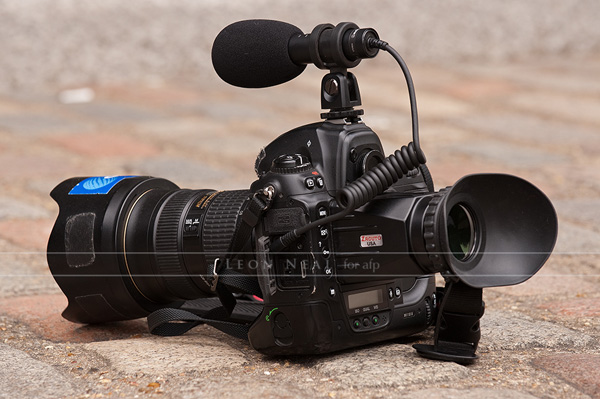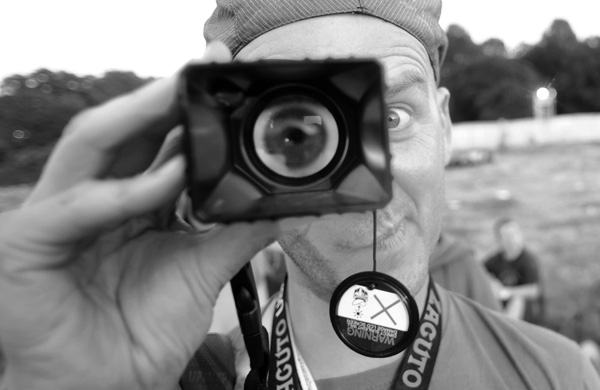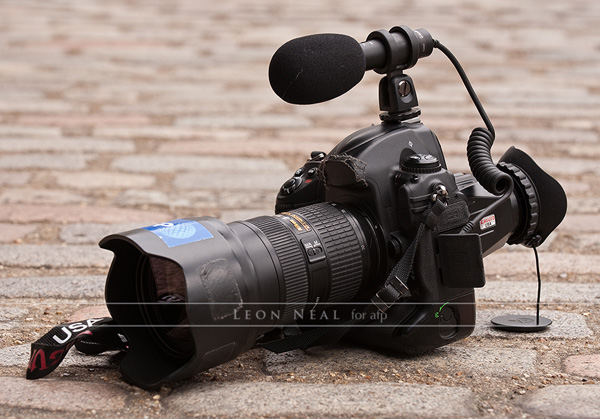UK based AFP staff photojournalist Leon Neal has been one of the company’s first in the UK to use DSLR for video

The Glastonbury festival 2010 was a new experience for me as this year would be my first attempt at trying to cover an event in both still and video. After requesting some new toys from the head office in Paris, they managed to get a Zacuto Z-Finder Jr and an Audio-Technica PRO24-CM couriered to me on the day before the festival. The downside to the tight delivery time was that the Z-Finder clip needs to be stuck in place and allowed to cure for 24 hours before use, so I had to bury it under all the camping equipment and photographic rubble in the boot of my car overnight with a stepladder pressing it into place. Thankfully, I hadn’t destroyed my D3s by the time I arrived on-site but anyone buying one should note that you can’t just use the eyepiece straight out of the box.

As I have touched on before on my own blog, I volunteered for multimedia training at AFP some time ago, with the opinion that not only is there no point in trying to hold back the technological advance but also if my employer is wanting to train me up and allow me to learn on company time, I’d be foolish not to accept the offer. Unlike some other agencies, AFP only expects “webclips” from their photographers as they have a full dedicated multimedia team already. A webclip is simply a ‘flavour’ of what actually occurred, without interviews, captions or extended footage. In a continuation of the role of the photographer as a “silent witness”, the video allows the viewer to experience the sounds and vibe of an event with (hopefully) very little bias or comment through composition etc. Aiming to send files of around 60 seconds to the edit suite, the MM team will then chop, crop and edit the footage in whichever way that they need so that it can be embedded into the AFP online news service. With this in mind, I was asked to provide whatever footage I could while shooting the weekend’s events.
After an initial five or six clips that had to be deleted due to me forgetting to turn the mic on (I told you this was all new to me..) I started to try to think in both still and moving images over the weekend. While my first attempts at video on Wednesday were pretty awful, by the end of the weekend, I had become a bit more used to switching between the two different ‘disciplines’ without too much fuss. While it proved a hindrance if I was trying to cover something that was happening quickly, such as goal reactions as fans watched the televised England World Cup matches, this was cancelled out by the chance to record aspects of the festival that have never really lent themselves to the still image, such as the silent disco. With the inclusion of audio, you can now understand how the disco works and that there really is no music audible to those passing by other than the sing-along chorus of the crowd.
The biggest problem that I’ve faced so far is overcoming what seems to be the most important single “danger” in video; camera shake. While dedicated TV and multimedia crews can carry around tripods for rock-solid stability, video is secondary to me so it must remain a light part of my kit. As I travel on public transport during the working day, I’m already overloaded with the tools I need to capture still images, never mind lugging a tripod around too. While the obvious answer may seem to be image stabilisation in lenses, the manufacturers have been slow in developing the much needed multi-use lens. For news, I want and need fast glass so really don’t like to buy anything below f2.8. However, the wide and midrange glass currently offered by both Nikon and Canon in this aperture range doesn’t include image stabilisation. If I want VR (vibration reduction) or IS (image stabilisation), I have to go to an f4 or above lens. Again, I’ll stress that if I had the use of a tripod, these issues wouldn’t be a problem, but trying to capture news on the fly in a fast moving situation already provides enough challenges before I factor in the use of legs on my camera.

While the Zacuto Z-finder jr helps by allowing me to ‘anchor’ the camera to my eye for an added point of stability, it still doesn’t deal with the problem fully. I’m aware that there are a variety of brackets and shoulder stocks available for this reason but again, it’s another thing for me to carry. As far as I can tell, the only answer is either move to f4 lenses with VR built in or hope that Nikon and Canon are aware of the customer base that are patiently waiting for something that addresses the issue. Rumours were buzzing around the camera forums last year that there would be a new series of 24-70mm f2.8 lenses with VR but, as yet, these have come to nothing.
As I finished writing the three Glastonbury blogs for www.leonneal.com and looked at the video again, I considered not publishing the video as I can see so clearly where I need to improve but I’m a believer in marking my development and as this is a starting point, it should give me something to look back on and laugh at hysterically (before sobbing as I realise that I shared it online). So here, in all it’s frequently wobbly glory, is my first proper attempt at video with the D3s. Knowing that there are countless photographers out there who are miles further down the line than me when it comes to video, all comments, tips, advice, criticism and cash donations (for no real reason) are appreciated.







